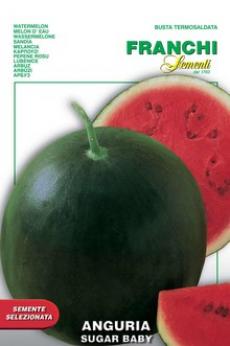
Watermelon, Anguria Sugar Baby
Watermelon, Anguria Sugar Baby round fruits of medium sized, consistent thick, dark green skin with a sugary, intense red flesh. This widely adapted heirloom variety is solid, dark green on the outside with a bright red, firm and fine-grained flesh that is super sweet. Watermelon contains high levels of healthy antioxidants, making Sugar Baby a great sweet way to pack in good nutrition.
Sugar Baby Cultivation – Tips For Growing A Sugar Baby Watermelon By: Amy Grant: What are Sugar Baby Watermelons? An interesting nugget about a Sugar Baby watermelon is its very high “brix” measurement. What does “brix” measurement mean? Commercial watermelon growers value melons high in sugar and the name for this sweetness is called “brix” and can be scientifically measured. As its name implies, Sugar Baby watermelons have a brix measurement of 10.2 and rank as one of the sweetest watermelon cultivars. Citrullus lanatus, or Sugar Baby watermelon, is an incredibly productive grower as well. Sugar Baby melons are round “picnic” or “icebox” watermelons perfect for small families and as the name suggests, small enough to fit into the icebox. They weigh in at between 8 to 10 pounds (4-5 kg.) and are 7 to 8 inches (18-20 cm.) across. They have either a dark green with slight dark veins or medium green with dark veined rind. The flesh is as mentioned; sweet, red, firm, and crisp mottled with very few small, tan-black seeds. Sugar Baby Cultivation Sugar Baby melons, like all watermelons, require warm, dry temperatures to thrive. This early watermelon cultivar was first introduced in 1956 and is an early maturing variety, maturing in 75 to 80 days. They do best in Mediterranean climates where the vines spread out 12 feet (4 m.) or longer, with each plant producing two or three melons. Most people start this melon via seed indoors at least six to eight weeks before outdoor planting time. These melons need rich, well-draining soil, amended with compost and composted manure. Plant them in an area with at least eight hours of sun exposure per day and account for at least 60 square feet of space per plant.
